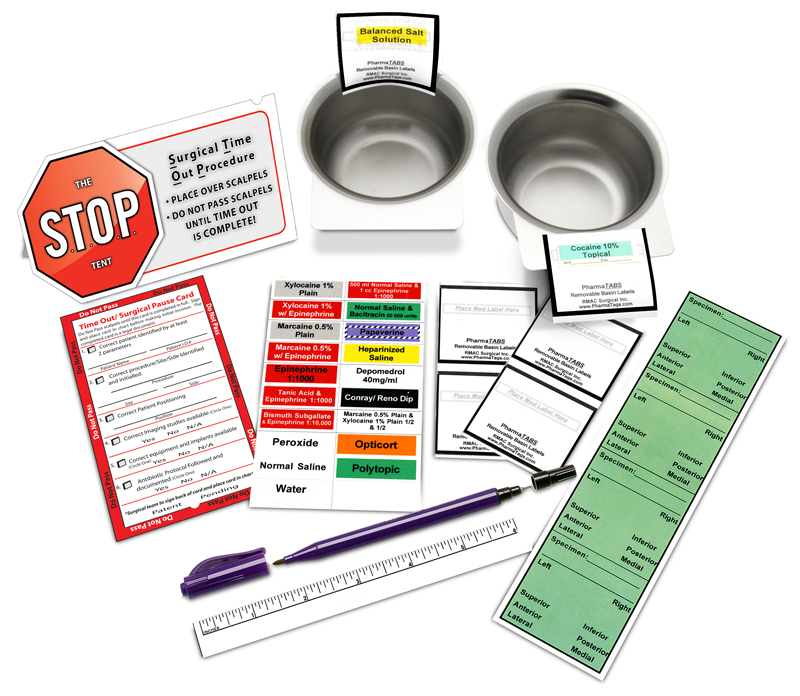
The
"Labeling Medications on the Sterile Field Policy" below is for
informational purposes only. You must use your professional judgement
to modify this Policy and Procedure to suit the needs of your institution.
Note: There are 2 philosophies regarding medication labels.
Color coded vs. black on white. Different hospitals have different
opinions on which to use.
Should your hospital choose to use color coded labels, the colors used
on labels should be based on The International Standard for User Applied
Labels in Anaesthesia and Critical Care. For example, each category of
drug, such as vasopressors, will be produced with Pantone color violet
256. This means that Neosynephrine and epinephrine, although different
drugs, will be the same color. All local anaesthetics should be printed
in Pantone color Gray 401, etc.. Therefore, lidocaine, marcaine etc..
will be Gray 401. Even though colors are used to identify classes
of drugs, the user must always read the label.
Other institutions choose to use a "Black on White" format. Hospitals
who subscribe to this philosophy believe that the nurse is forced to
always read the medication name on the label rather than relying on
a color, especially during urgent situations. They believe that
the risk of making a medication error is reduced as the User does not rely
on a color alone.
It is up to each institution to choose which philosophy they wish to
use.
Policy:
1. All medications placed on the sterile field will be properly
identified using sterile medication labels.
This policy includes medications contained in solution bowls, medicine
cups, and syringes.
2. All medications placed on the sterile field will be checked
by two (2) Registered Nurses or one Registered
Nurse and a Surgical Scrub Technician (SST).
3. This policy applies even when there is only one medication on the field.
4. Normal Saline, Water, Lactated ringers, and all other solutions will be considered as medications for the purposes of patient safety.
5. This policy satisfies the 5 "Rights" of medication administration. Right Patient, Right medication, Right dose, Right Route, and Right Time.
Procedure:
Right Patient: As per hospital protocol, patients will
be admitted to the operating room. Proper identification using the
patient's armband and chart will be followed.
Right Route: Most medications in the OR are in the IV
injection form. However, some meds, such as creams and other topicals
are used. The circulating Nurse will acquire the proper form of the
drug as needed.
Right Time: Time of administration is considered as "Now".
Right Drug and Right Dose:
When a medication is required on the sterile field Nursing staff
will abide by the following procedure to ensure patient safety.
1. The Circulating Nurse obtains the needed medication from the
storage locker or from the satellite pharmacy.
2. The Circulating Nurse will hold the medication vial in view
of herself and the Scrub Nurse or SST.
3. The Circulating Nurse will read the name of the medication
and the dosage printed on the medication vial to the Scrub Nurse or SST.
4. The Scrub Nurse will read the name of the medication and the
dosage printed on the medication vial to the Circulating Nurse.
5. The Circulating Nurse will read the expiration date of the
medication printed on the medication vial to the Scrub Nurse or SST.
6. The Scrub Nurse or SST will read the expiration date of the
medication printed on the medication vial to the Circulating Nurse.
7. The Scrub Nurse or SST will draw up the medication using proper
aseptic technique.
8. The Scrub Nurse or SST will obtain and read the medication
label to the Registered Nurse while the Registered Nurse observes and verbally
acknowledges that the proper label has been placed onto the syringe, solution
bowl, and/or medicine cup.
9. Once the medication is administered, the Circulating Nurse
will document the administration on the operative record. A "total"
dosage will be calculated and documented on the operative record towards
the end of the procedure.
Considerations:
When a surgeon or PA requests a medication be passed to him/her, the
scrub nurse or SST will read the label aloud to the surgeon or PA that
is printed on the syringe label.
The circulating nurse, scrub nurse, and SST must be aware of any allergies that the patient has.
Should a syringe, solution bowl, or medicine cup be found on the table without a medication label, the medication will be thrown away.
Once the medication is drawn into a syringe , it should not leave the hand of the Scrub Nurse or SST until the proper medication label is applied to the syringe, solution bowl and/or medicine cup.
During change of shift or break relief, a proper report identifying
all medications on the sterile field will be given to the next Registered
Nurse or SST.